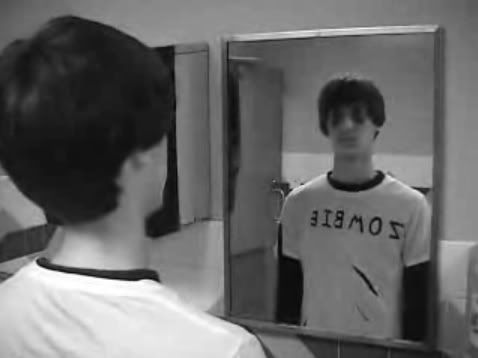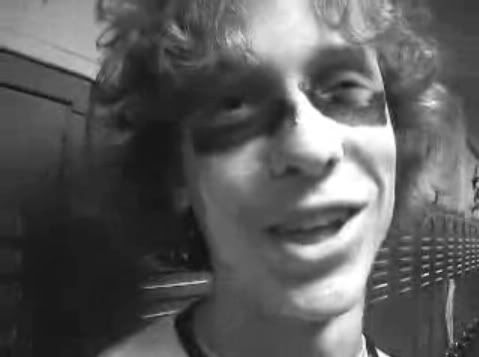
Our second Golden Bortons interview: Autumn McPherson, better known as Stumbleine, on
Zombie Girls Don't Cry.
Click here to watch the movie!KS: What was the origin of the idea of this project?
AM: My fellow classmates and I were all set to film a cheesey 1960's style black and white sci-fi thriller called "
Zombie Lawyers from Outer space", for the BAR association contest when they all bailed out on me because they didn't want to put in the time and effort it would take. I had my heart set on doing a
zombie flick, but now since our project would literally take one day, I decided to do my own film and thats when I started brain storming with Anton Phibes, sending him ideas for quirky scenes which he would quickly deliver back to me eliquently put in script format.
KS: What were some of your earliest efforts in filmmaking?
AM: My earliest memories behind a camera was when I was five or so. My dad who I barely know now let me use his camera at a play place restaraunt and I filmed my feet going down slides over and over. Then in highschool I stole my parents camera and pretty much filmed my entire highschool experience, until I got sick of school and dropped out to become homeschooled. I messed around with stop motion a little, made silly films with friends about drugging drag queens and avant garde music videos for french pop songs.
KS: What made you want to make movies?
AM: The Labyrinth, I wanted to make a world where I too could put David Bowie in reveling tights and big hair. Although originally I was planning on just being strictly a music video director, I wanted to make the smashing pumpkin videos, I think thats when I made my mind up that I wanted to direct was when I watched the making of their music videos. The video "Tonight Tonight" was beautiful and I wanted to create something that beautiful that was my own. That was the key thing that motivated me to go to film school.

KS: What were some of your influences (film and otherwise) for Zombie Girls Don't Cry? What about your filmography in general?
AM: A big influence for
Zombie Girls Don't Cry is the movie
Harold and Maude, I borrow that almost 70's style of dark comedy for this piece. Also the works of Wes Anderson inspired me. I believe his and Woody Allen's works have inspired my general filmography, that and old time comedies, like those the Marx brothers and Charlie Chaplin created.
KS: Zombie Girls Don't Cry is a very subtle, brief piece, a very delicate little story. When did you feel that you had given just enough of your message in its brief duration, and with generally subtle nuances? And what is that message/idea behind it, if any?
AM: Zombie girls was actually intended to be about a half an hour long. The project was abandoned after big complications. The story had continued to the two falling in love through a quirky trick or treat scene (which was actually filmed but has not been view by anyone but myself), a run in with a barber shop, and other cute dark comedy moments added in. But when she brings the
zombie boy home to meet the parents things don't go as planned. She's forbidden from seeing him (a bit of
zombie prejudice happening) and ends up crying alone in her room (You see, she crys a lot in the movie!) and then runs away to the cemetery to be with the
zombie boy, her dad comes after her, afraid that he's lost her, and in fact he has, shes allowed
zombie boy to turn her into a
zombie as well, and therefore she has no reason to cry anymore.
This story actually came true in my very own life shortly after. Not with a
zombie boy of course, and my parents didn't get in the picture, but I was left for another woman and ended up alone and just as misrebel as Sophia, and soon there after was saved and fell in love with a wonderful quircky character myself. It's funny how a story I created was projected so ironically into my real life. I really wouldn't change it for the world.
KS: Make-up effects are often pivotal in your work. Do you find some reason on why you gravitate to that sort of visual expression in film?
AM: It was a big necisity for me to have effects in the film, you cant have a
zombie without some make up. Unless you happen to know a real
zombie, sadly, i've yet to meet one myself. I did the make up myself, fully stocked up after halloween for the sales, I actually, a year afterwards, am still pleantiful in
zombie makeup.

KS: At first glance, the use of such soft folk music with the zombie theme would seem like a striking juxtaposition. How did you feel these two elements would fit well together?
AM: I loved the idea of putting the folk music with the film, probably again a big influence from the use of Cat Steven's music in "Harold and Maude". I had first envisioned the film while listening to Simon and Garfunkle. I knew I couldn't use their music if I wanted to do anything with the film. So I remembered a local folk musician called spitzerspace telepscope. I wrote him and asked if I could use his music (which seemed to fit perfectly with ever scene I had in mind, if you really listen to the lyrics, you'll get it.) and he said yes and sent me a free cd.
KS: Do you have any future projects in mind?
AM: A film called "Lustre" I've been saying i'm going to do for about a half a year now. Maybe in november i'll have time to do it, but I still would have a lot of work to do to get to the point of filming it. It's a short about a knife thrower and his assistant's first show.
KS: What sort of advice would you give fellow aspiring filmmakers?
AM: Make friends that you can rely on in the film world, always be there to hold their boom mic or be script supervisor on their films and they will be for you. I would have never been able to make what I did of
Zombie Girls if I didn't have amazing friends who stood out in the cold all day without any complaints.












